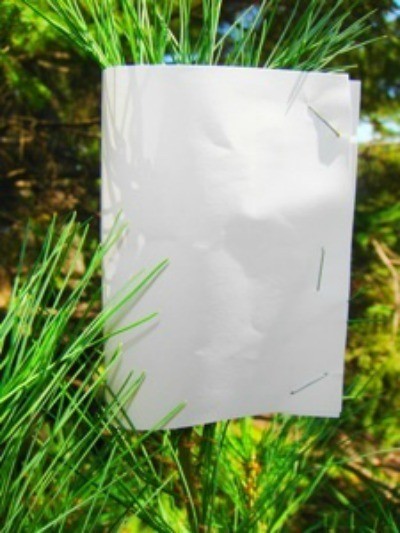
Young trees are a favorite snack of hungry deer, especially in the spring and fall while there's still snow on the ground. Most young pines can recover from minor amounts of repeat browsing as long as the terminal bud remains intact. Here is a cheap and effective solution to protect terminal bud clusters and help get your pine seedlings get through the winter.
A tree seedling's terminal bud (the bud or cluster of buds at the very top of the tree), is a key factor in determining the overall height and future growth of the tree. As long as the terminal bud remains undamaged, growth continues in a vertical manner and the tree's natural shape is maintained. However, when the terminal bud is eaten or damaged, growth can become restricted, deformed and unbalanced. Many trees will never achieve their natural shape or true growth potential once their terminal bud is chewed off by deer. They may adapt when an adjacent branch bends upward and eventually takes over as the "leader" branch, but their growth and form may be forever compromised.
Bud capping is a method of protecting tree seedlings that has been used in forest management for years. It involves stapling a small "cap" made from paper around the terminal bud cluster on the leader branch. The caps are typically applied in the fall before snow cover forces the deer to start nibbling on whatever they can find above ground.
To construct bud caps, cut paper into 4 x 6 inch pieces. Use the lightest weight paper possible (fax, photocopy, notebook, etc.) so that new growth can push through easily in the spring. White pines have fragile terminal buds, so the paper should only be 3 x 4 inches in size. The weight of snow sticking to the paper can cause the terminal bud to bend over, and a smaller piece of paper will not catch as much snow.
Using a common office stapler, fold the piece of paper around the terminal bud of the leader branch and using three staples, staple it to some needles near the top. The paper should be positioned so that the terminal bud cluster is at least 1/2 inch below the top of the paper, but no lower than the paper cap's mid-point.
Bud caps are usually used on conifers, but hardwood seedlings (like oak) can be bud capped, too. This can also be done during the dormant season (fall), however they typically get browed most heavily as new growth emerges in the spring. As an alternative to paper bud caps, hardwood seedlings can be protected with ordinary latex party balloons. These can be applied in the fall after the seedling goes dormant (leaf off) and removed again in the spring (April/early May) before bud break. Use a balloon with the appropriate size opening and pull it down over the top buds and down over the stem. The bottom end of the balloon (the open end) can then be stretched out and stapled shut close to the stem to keep it secure.

About The Author: Ellen Brown is an environmental writer and photographer and the owner of Sustainable Media, an environmental media company that specializes in helping businesses and organizations promote eco-friendly products and services.
Add your voice! Click below to comment. ThriftyFun is powered by your wisdom!
My experience with bud caps is that these work as long as deer are not in starvation mode. Once is starvation mode, they will break the terminal stem to try to get at the capped bud. Snow cover has been low this winter, around a foot or so, allowing more limbs to be exposed for grazing. So this year, apart from all the lower buds, I've lost the terminal buds of half of my five to six year old pines...and counting. . And judging by how high they stand on their hind legs, you would have to get to 10' high before the terminal bud was safe on its own. How do you know deer are in starvation mode? First signs typically show up in January when the eastern cedar runs out. They then start eating more eastern white pine, when that runs out, they go after spruces of all kinds, larch and yes, even junipers. Nothing is safe in the evergreen world, at least not where I am, in southern Québec. What don't they touch? In my experience, anything in the Russian Olive family (eleagnus angustifolia), buckthorn (same type species). Apart from that, everything gets a variable degree of nibbles, all depending on the starvation level of the deer. Most leafy plants recover well, but as stated in this article, evergreen munching is mostly always permanent damage.
Add your voice! Click below to comment. ThriftyFun is powered by your wisdom!